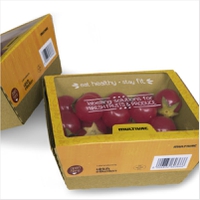
According to the company, around 60% of fresh fruit and vegetables in Germany are sold pre-packed in retail outlets. Two-thirds of the packs are based on plastic and the remaining one-third are on cardboard or other paper fiber materials.
The packs offer many benefits for preserving fresh produce. Most importantly, they improve shelf life, therefore, making a major contribution to preventing food waste as a result of premature spoilage.
In addition to this, packaging fresh products results in a more stable CO2 emission. The latest studies show that the ecological footprint of a processed food product is generally up to 30 times higher than the footprint of its packaging.
However, Multivac says it believes that in spite of the packaging being generally less environmentally harmful than processing foods, every gram of packaging material saved helps the environment.
Two concepts, one purpose
Multivac’s two concepts for the closure, sealing and labeling of fruit and vegetable trays come as a result of this belief in saving material. Top Close seals the tray closed with a label from above, as opposed to Top Wrap, which includes putting a label on the top and both sides of the tray.
According to Multivac, both concepts are fitting options for packaging any fresh products that don’t need to be packed in a vacuum or under a modified atmosphere.
This implies that a label can be applied to secure it shut, but also provide an “attractive” label. The company says that one thing unites both labeling options: the “visually appealing” labels and recyclable packaging both serve as strong purchasing incentives.
Wrapping up efficiently
In addition to providing a sizable area for marketing and customer information, self-adhesive labels on backing materials also provide a wide range of presentation options for products in terms of material thickness and label shape.
To avoid interaction with the product, it is feasible, for instance, to have cut-outs in the label and adhesive-free zones. The packs are easier for the consumer to handle because of the perforations, which act as opening aids.
Top Wrap includes a label that is only put to the top and two sides, not around the entire pack, in contrast to traditional full wrap labeling. By doing this, resources are ultimately conserved and the label serves its intended purpose.
Michael Reffke, product manager for Labelling Technology at Multivac Marking & Inspection emphasizes that “thanks to a combination of cardboard trays and standard self-adhesive labels made of paper or renewable materials, this produces a pack that can be sorted perfectly into its separate components for recycling.”
PP power
In addition, PP film labels can also be utilized with Top Wrap. PP labels are advantageous because of the transparent window on the top of the tray, giving the best possible view of the product. The tray’s contents are also guarded against coming into contact with the label adhesive since the backing material is not peeled off in this area.
Reffke says, “the proportion of plastic in such a pack is under 10% depending on the label material used. The label can also be easily removed, making it simple for the consumer to separate the materials into the different recycling channels.”
Top Close offers the same transparent lid, and the same area without adhesive to protect foods against chemicals, however, with Top Close the trays are automatically labeled on the run, and they are either fed in manually or transferred automatically from an upstream module.
Labeling with Top Close produces an output of 200 products per minute and when compared with conventional time-consuming, manual packaging solutions. The company pegs these solutions as cost- and time-efficient.







